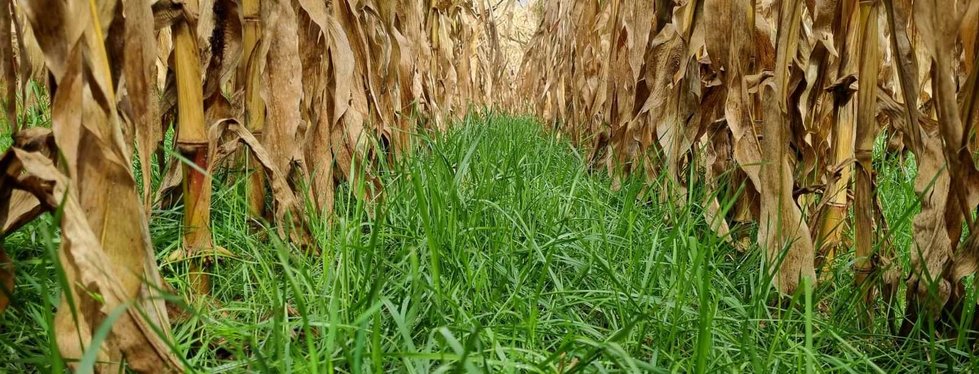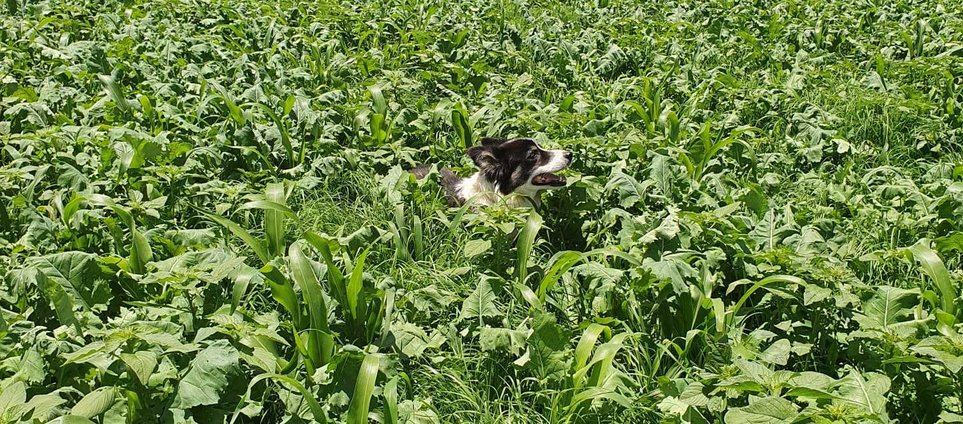Double cropping into maize
Intercropping is no new feat, nor is the challenge to maintain production throughout winter. The adoption of cover cropping into dairy and beef systems is motivated by soil health benefits and added green feed in the periods between rotations. Necessity has brought about the grazing of maize stover’s proceeding harvest, which does not present a well-rounded diet, in isolation. The opportunity to marry the two concepts may be dual-beneficial. With research done into the Carbon, Nitrogen ratio of soils and crops, alike, it is possible to select a very specific cover crop combination to compliment the maize stover, as well as maintaining an ideal C:N ratio to benefit the soil and ultimately your next maize crop.

C:N Ratio
Much like rumen microbes who work to feed the cow, soil microbes work to supply nutrients to plants. Soil microbes require a carbon to nitrogen ratio of 24:1 to optimally breakdown plant material and ultimately release nutrients to be taken up by the next plant. Plants with a low C:N ratio, such as legumes, are more readily degraded in the soil, whereas plants with a higher ratio, e.g. maize stovers, take a bit longer to breakdown. Nitrogen is critical to these microbes, and if nitrogen is not provided to them by this plant material or other sources, they will scavenge whatever nitrogen they can find in the soil, thus reducing nitrogen available to our crops. By providing an appropriate cover crop that will complement the existing residues (e.g. maize stover) and the next crop rotation, soil microbes can efficiently breakdown these materials and exude nutrients back into the soil to be taken up by the next crop. The C:N ratio and relative degradability of a plant is affected by several factors, including the maturity of the plant and the microbial state and health of the soil and water availability. More mature plants tend to be more fibrous, and show a higher C:N ratio with slower degradation.
Choosing your cover crop
Choosing a cover crop can be seen as an investment for the follow-up crop. This investment should be capitalised by selecting a cover crop mix that will benefit and compliment the follow-up crop. If the next crop is maize, you want a cover crop that has a lower C:N ratio, i.e. a higher legume component and annual ryegrass. Should the follow-up crop be a legume, e.g. soyabeans, a higher C:N cover crop will be optimal, i.e. cereals (oats, stooling rye).

A summer cover crop mix of Barenbrug’s Tiffany teff, Barsweet sweet sorghum and Interval rape.
Key to success
Like agriculture itself, no factor of intercropping and cover cropping can be looked at in isolation. The timing of your intercropping plays a significant role in its success into/behind maize, coming in at the right time of the maize crops cycle, to capture remaining moisture and capitalize on the canopy protection for seeds to establish and then flourish when the canopy opens at dry-off and combining. The amount of moisture in the soil affects the microbial activity, which in turn affects the breakdown of residues and nutrient availability. Amongst other factors, keys to success can be reduced to a trinity of timing, moisture and species selection, all of which contribute to a successful intercropping season.
Methods of cover cropping
With each operation being different, a cover crop has an expanse of purposes. Drilling in behind maize silage allows us to capture and retain the moisture in the soils, and get a head start on our green feed. Over sowing into maize grain is an opportunity to overlap production seasons so that fodder flow can remain stable. With the collaboration of tradition and technology, drones have been used to fly seed on above maize grain, with the down draught of the propellers aiding seed settlement on the soil.
Cover cropping into maize
The motivation behind cover cropping is to establish a winter pasture by overlapping with maize. The principle is to go into the maize from V-4 stage onward, where seedlings can establish in a shaded and protected environment. The cover crop then grows to a point and idles, waiting for that maize canopy to open up. When the maize dries and the canopy opens, or is taken off completely, the influx of sunlight prompts rapid growth of the cover crop.

‘Cover’ yourself with cover crops
The art of growing maize carries inevitable risks, hail, fire and waterlogging, which could be marginally mitigated by incorporating intercropping. Damage to maize crop caused by hail will favour the cover crop, providing greater green feed. The loss of yield to the maize crop can be slightly compensated for by the increased production of your cover crop from the influx of sunlight.
The opportunity to double crop is one worth exploiting!
By Jamie Young

